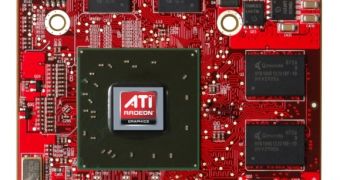AMD has just unveiled its latest Mobility series, comprised of Mobility Radeon HD 3600 and 3400 cards. The new cards feature graphics processors built with the 55-nanometer technology. Both models include support for PCI Express 2.0 and DirectX 10.1 as well as the dedicated unified video decoder (UVD).
The lowest-end card in the series is the HD 3400, with a 55-nm node GPU featuring 181 million transistors. The card also has a 64-bit GDDR2/3 memory interface, 40 stream processing units, and includes the PowerPlay 7.0 power management technology.
The HD 3600 is an evolved model that aims at a different market. The GPU includes 378 million transistors, and 120 stream processors. It also features a 128-bit memory interface that supports 4 DDR2 chips. Although the HD 3600 chip features a larger thermal envelope than the "younger" HD 3400, it is still optimized for use within notebooks.
Both the 3400 and the 3600 chips feature two independent display controllers for two dual-link DVI, one HDMI and two DisplayPort outputs. The two graphics processors are the first elements of a new mobile platform, called Puma, a fierce opponent for Intel's Santa Rosa mobile platform.
The new generation of discrete graphics processors adds a plus of performance in graphics processing, both during gaming and high-definition content streaming, while keeping the CPU load as low as possible. The Unified Video Decoder allows the user watch high definition HD-DVD and Blu-Ray movies at full 1080px resolution (if the video display supports it) with maximum versatility due to the wide array of digital outputs.
As both chips are part of a mobile platform, energy efficiency is a key factor. The HD 3000 series graphics processors have a reduced thermal envelope with exceptional performance-per-watt. The included technology dynamically balances power and performance to increase the battery life.

 14 DAY TRIAL //
14 DAY TRIAL //